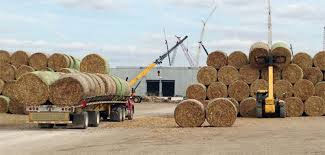The first biofuel plant that runs on corn waste has begun commercial production in Iowa – Project LIBERTY.
POET – one of the big corn ethanol companies – will produce 25 million gallons of cellulosic ethanol a year from the plant for use in transportation fuels. Yeast and enzymes convert corn cobs, leaves, husks and stalk into fuel. Corn waste will be sourced from 450 farmers that are within 30-40 miles of the plant and it runs on a biogas anaerobic digester and solid fuel boiler.
Farmers typically regard corn stover as waste and have to pay for it to be removed. Now they will get paid instead and still have plenty to mulch the soil.
To come up with locally sourced, sustainable processes that can turn agricultural products into fuel, the Department of Energy (DOE) has invested $100 million in research and development (since 2007) in the cost-shared project with POET and Dutch enzyme-maker DSM Royal.
Most important, they developed a cost-effective process for producing cellulosic ethanol with biochemical conversion technologies, which now serves as a test bed for the industry.

POET says it will incorporate the technology in its 27 grain ethanol plants. Its goal is to produce 3.5 billion gallons of cellulosic ethanol by 2022 from wood, grass and agricultural waste. It expects the fuel to sell for around $3 a gallon.
This is only the second commercial-scale biorefinery in the US. A much smaller 8 million gallon a year facility came online last year in Florida, running on grass, wood chips and municipal solid waste – INEOS Bio’s Indian River BioEnergy Center.
Also supported by DOE, biomass is converted using a hybrid gasification/ fermentation technology. It produces energy for heat as well as transportation fuel.
In 2012, DOE’s National Renewable Energy Lab demonstrated how cellulosic ethanol could cost $2.15 a gallon, down from $9 a decade ago.
DOE finds that lifecycle greenhouse gas emissions for cellulosic ethanol are 60% lower than petroleum-based fuel and could eventually replace about 30% of it, but others seriously question that.
Research also shows that using E15 blends in gas would reduce cancer-causing pollutants and smog from vehicle exhaust and evaporative emissions.
Read our articles, Cellulosic Biofuels Finally Gaining Ground and Can Biofuels Make a Dent in Replacing Petroleum?
Municipal Solid Waste for Jet Fuel
The first biofuel plant for the aviation industry got a boost from the Department of Agriculture’s Biorefinery Assistance Program, which closed on a $105 million loan guarantee to Fulcrum Sierra Biofuels.
The feedstock – municipal solid waste – is considered a key waste stream if we hope to replace significant amounts of petroleum. Everything that can be recycled or composted is removed before processing begins.
Fulcrum’s $266 million project will convert 147,000 tons of waste a year into 11 million gallons of biodiesel at a facility in Nevada.
Cathay Pacific Airways is investing in the parent company, Fulcrum Bioenergy, and has contracted for 375 million gallons of fuel over 10 years – about 2% of its annual consumption.
Not surprisingly, the oil industry (with ALEC’s help) is working hard to repeal the Renewables Fuel Standard, which requires certain amounts of biofuels to be blended into fuels. Republicans plan to vote soon on bills that would repeal the policy, which is largely responsible for the emergence of the industry. The EPA now allows natural gas from landfills, biogas from wastewater treatment facilities and farms and separated municipal waste to qualify as renewable fuels. The mandate for incorporating ethanol from corn was eliminated this year.
Learn more about DOE’s biofuel efforts:
